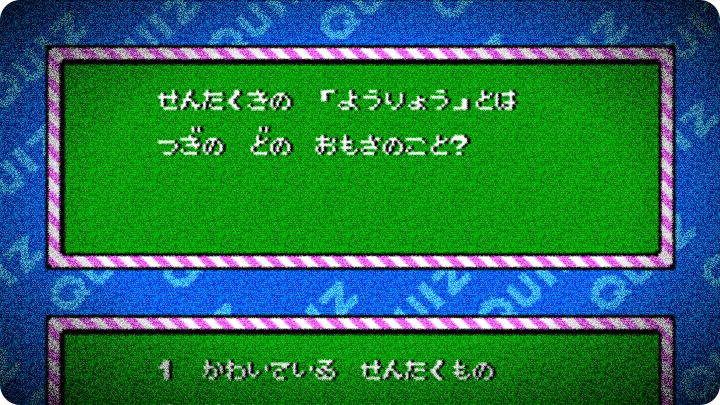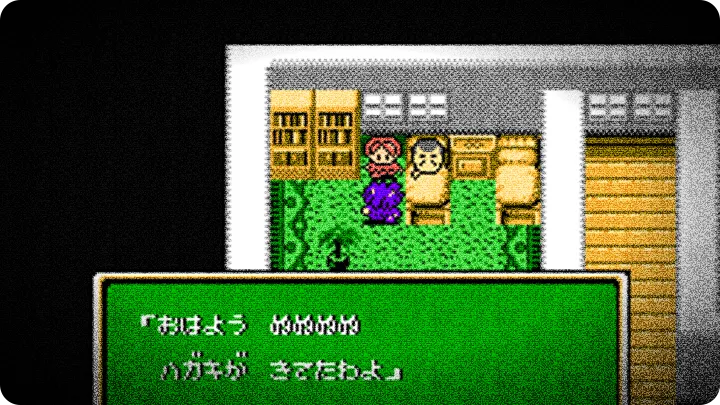 The CRT is glowing, the posters are neon, and we are launching into America! Ōdan Ultra Quiz: Shijō Saidai no Tatakai. Fun fact before we start: the team behind this type of licensed quiz adaptation often included producers from television quiz shows, not just game designers. You can feel that pedigree in the pacing and presentation. The trivia voiceover has a practiced cadence, as if we stepped into a live studio recording from the other side of the screen.
The CRT is glowing, the posters are neon, and we are launching into America! Ōdan Ultra Quiz: Shijō Saidai no Tatakai. Fun fact before we start: the team behind this type of licensed quiz adaptation often included producers from television quiz shows, not just game designers. You can feel that pedigree in the pacing and presentation. The trivia voiceover has a practiced cadence, as if we stepped into a live studio recording from the other side of the screen.
 I can already hear the announcer voice. Story mode is peculiar for a quiz game. You walk top-down, avoid traffic, and earn entries to competition halls. That blend of adventure and trivia is ambitious. Right now, I am guiding our custom character through town. Timing crossings around cars turns what could be a simple menu choice into something tense.
I can already hear the announcer voice. Story mode is peculiar for a quiz game. You walk top-down, avoid traffic, and earn entries to competition halls. That blend of adventure and trivia is ambitious. Right now, I am guiding our custom character through town. Timing crossings around cars turns what could be a simple menu choice into something tense.
 A gameplay highlight appears right away: the mini-game answers. Instead of picking A, B, C, or D, you run to the touchdown zone for yes/no on a giant football field. In other rounds, you move to the region of a top-down map that matches the correct answer. It makes the knowledge test feel kinetic. Tournament mode strips that away for a quicker, purer quiz—good for practicing without the traffic hazard.
A gameplay highlight appears right away: the mini-game answers. Instead of picking A, B, C, or D, you run to the touchdown zone for yes/no on a giant football field. In other rounds, you move to the region of a top-down map that matches the correct answer. It makes the knowledge test feel kinetic. Tournament mode strips that away for a quicker, purer quiz—good for practicing without the traffic hazard.

 There is real charm in turning trivia into action. However, that charm is also the game’s biggest compromise. The walking controls are serviceable but not refined. Bumping into a parked car can cost time or lives, which feels arbitrary in a quiz that should reward knowledge, not collision luck.
There is real charm in turning trivia into action. However, that charm is also the game’s biggest compromise. The walking controls are serviceable but not refined. Bumping into a parked car can cost time or lives, which feels arbitrary in a quiz that should reward knowledge, not collision luck.
 Hot tips I’ve picked up while playing:
Hot tips I’ve picked up while playing:
- Memorize the time limits for each mini-game; knowing your leeway changes how risky you can be with navigation.
- In story mode, remember that not every incorrect answer is punished equally—some mini-games allow recovery if you learn their patterns.
- Use tournament mode to drill obscure geography facts. The opponents’ buzzer timing is consistent, so you can train reflexes without hazards.
- For yes/no questions, treat football field runs like platforming—watch for opponents who block your best route.
 Speaking of opponents, the AI in tournaments is interesting. They are predictable in tendencies. Some press aggressively on easy questions, others wait for complex ones. This makes the single-player competition feel like facing eight distinct personalities in one arcade cabinet.
Speaking of opponents, the AI in tournaments is interesting. They are predictable in tendencies. Some press aggressively on easy questions, others wait for complex ones. This makes the single-player competition feel like facing eight distinct personalities in one arcade cabinet.

 One memorable moment came during a late-round geography gauntlet. The mini-game asked us to place contiguous states on a small map. I careened our character across the top-down city, dodged a van, and slammed into the correct region with half a second to spare. The announcer’s piano sting and the swelling crowd noise felt genuinely triumphant—like a TV-show climax built from 8-bit parts.
One memorable moment came during a late-round geography gauntlet. The mini-game asked us to place contiguous states on a small map. I careened our character across the top-down city, dodged a van, and slammed into the correct region with half a second to spare. The announcer’s piano sting and the swelling crowd noise felt genuinely triumphant—like a TV-show climax built from 8-bit parts.
 The final boss is staged as the Grand Quiz. It’s a long series of mini-games and direct-answer rounds. Also, the pressure ramps up. Timers shorten, mini-games combine elements, and the music becomes a relentless drum. The last sequence left us breathing hard, like we had finished a race. It feels like a true finale, even if the “boss” is just the quizmaster and a brutal schedule of rounds.
The final boss is staged as the Grand Quiz. It’s a long series of mini-games and direct-answer rounds. Also, the pressure ramps up. Timers shorten, mini-games combine elements, and the music becomes a relentless drum. The last sequence left us breathing hard, like we had finished a race. It feels like a true finale, even if the “boss” is just the quizmaster and a brutal schedule of rounds.
 A candid note: the production values are uneven. The quiz writing is sharp and well-researched. The graphics and collision detection in the top-down exploration, however, can make the game feel older than it should. Players invested in trivia and movement-based answering will forgive this. Players seeking a polished action-adventure may find it frustrating.
A candid note: the production values are uneven. The quiz writing is sharp and well-researched. The graphics and collision detection in the top-down exploration, however, can make the game feel older than it should. Players invested in trivia and movement-based answering will forgive this. Players seeking a polished action-adventure may find it frustrating.

 The game’s pacing is one of its strengths. Tournament mode is quick and satisfying; story mode offers an unexpected layer of progression and a light sense of world-building as halls open. The sound design supports the studio vibe nicely—brass hits and applause help sell the atmosphere. But if you are allergic to repetition, expect some rounds to loop similar question patterns, which can feel padded after many hours.
The game’s pacing is one of its strengths. Tournament mode is quick and satisfying; story mode offers an unexpected layer of progression and a light sense of world-building as halls open. The sound design supports the studio vibe nicely—brass hits and applause help sell the atmosphere. But if you are allergic to repetition, expect some rounds to loop similar question patterns, which can feel padded after many hours.
 For anyone picking this up in the era of shoulder pads and VHS tapes, here are concise hot tips to remember:
For anyone picking this up in the era of shoulder pads and VHS tapes, here are concise hot tips to remember:
- Practice in tournament mode to learn buzzer timing.
- Learn the mini-game routines—most have exploitable paths.
- Save your best reflexes for the Grand Quiz; the final sequence punishes hesitation.
- Accept that collisions are part of the design and plan routes accordingly.
 Overall, it is a game with a very clear identity. It knows it is a quiz show at heart and pursues that with some creative gamified answers and earnest studio flair. There are rough edges—control imprecision and occasional repetition—but the concept is executed with enough care to make both casual quick sessions and longer story-mode attempts worthwhile.
Overall, it is a game with a very clear identity. It knows it is a quiz show at heart and pursues that with some creative gamified answers and earnest studio flair. There are rough edges—control imprecision and occasional repetition—but the concept is executed with enough care to make both casual quick sessions and longer story-mode attempts worthwhile.

 I agree. It is not flawless, but it delivers a unique blend of genres and the final gauntlet is genuinely satisfying. The studio-show feel is credible, the mini-games add life to trivia, and when everything clicks, it captures the thrill of being on a quiz show—complete with a nervous pal beside you holding a controller and the television humming in the background.
I agree. It is not flawless, but it delivers a unique blend of genres and the final gauntlet is genuinely satisfying. The studio-show feel is credible, the mini-games add life to trivia, and when everything clicks, it captures the thrill of being on a quiz show—complete with a nervous pal beside you holding a controller and the television humming in the background.
more info and data about America! Ōdan Ultra Quiz: Shijō Saidai no Tatakai provided by mobyGames.com

